Do not open the file attached to the New Fax Received email scam
Phishing/ScamAlso Known As: New Fax Received spam
Get free scan and check if your device is infected.
Remove it nowTo use full-featured product, you have to purchase a license for Combo Cleaner. Seven days free trial available. Combo Cleaner is owned and operated by RCS LT, the parent company of PCRisk.com.
What is New Fax Received email scam?
Scammers use phishing emails to trick recipients into providing personal information (for example, credit card details, login credentials). Typically, they pretend to be legitimate companies, organizations, or other entities and include a link to some deceptive website in their emails. This phishing email contains a link designed to open a fake Microsoft page.
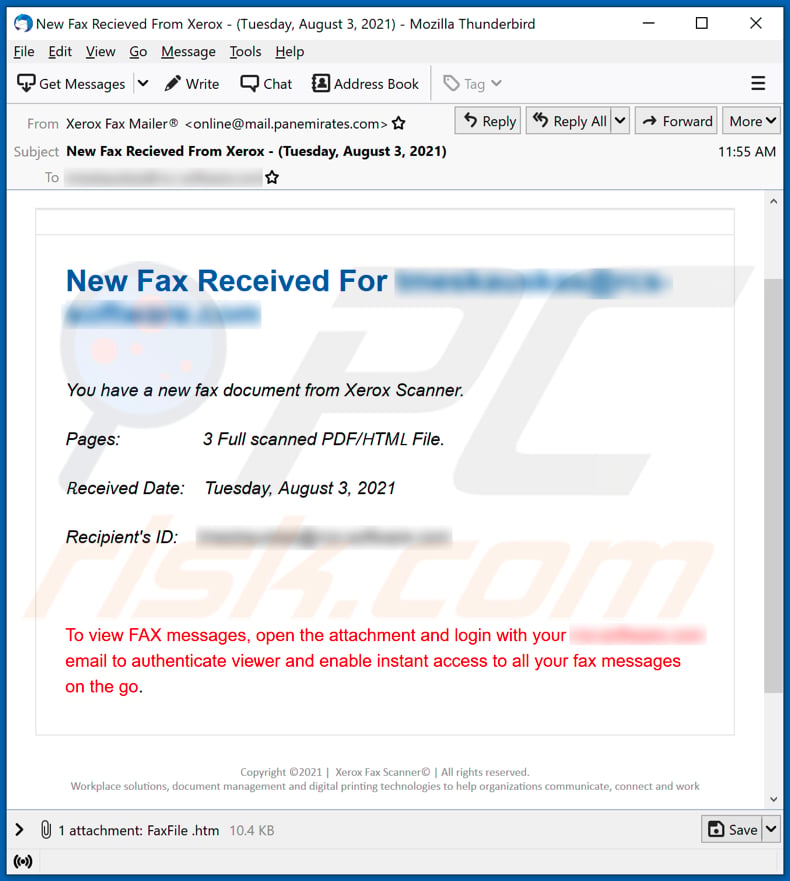
New Fax Received phishing email in detail
Scammers behind this phishing email seek to trick recipients into believing that they have received an email notification about a fax message (three scanned PDF and HTML files) received via Xerox scanner. Their goal is to deceive recipients into opening the attached file ("FaxFile .htm") and then entering their login credentials on a fake Microsoft site.
The aforementioned website is designed to look like a Microsoft login website. It asks to enter an email address and a password (login credentials) so sign in. This page sends entered data to a remote server controlled by scammers behind a phishing email used to promote it - scammers use it to steal login credentials.
Usually, scammers use stolen login credentials to hijack email, banking, social media, and other accounts and use them to commit identity fraud, send spam, deliver malware, make fraudulent purchases, transactions, and so on. It depends on the types of accounts that they have managed to access.
It is important to mention that scammers try to access multiple accounts using the same login credentials since some users use the same login credentials for more than one account. Therefore, it is strongly recommended not to use the same login credentials for multiple accounts.
| Name | New Fax Received Email Scam |
| Threat Type | Phishing, Scam, Social Engineering, Fraud |
| Fake Claim | New fax recieved from Xerox |
| Attachment | FaxFile .htm (its name may vary) |
| Detection Names (FaxFile .htm) | AhnLab-V3 (Phishing/HTML.Generic), Fortinet (HTML/Phishing.B95A!tr), ESET-NOD32 (HTML/Phishing.Gen), Ikarus (Phishing.HTML.Doc), Full List Of Detections (VirusTotal) |
| Symptoms | Unauthorized online purchases, changed online account passwords, identity theft, illegal access of the computer. |
| Distribution methods | Deceptive emails, rogue online pop-up ads, search engine poisoning techniques, misspelled domains. |
| Damage | Loss of sensitive private information, monetary loss, identity theft. |
| Malware Removal (Windows) |
To eliminate possible malware infections, scan your computer with legitimate antivirus software. Our security researchers recommend using Combo Cleaner. Download Combo CleanerTo use full-featured product, you have to purchase a license for Combo Cleaner. 7 days free trial available. Combo Cleaner is owned and operated by RCS LT, the parent company of PCRisk.com. |
Phishing emails in general
In conclusion, scammers use this phishing email to trick recipients into providing their email addresses and passwords via the attached HTML file designed to open a website that looks like a Microsoft page. Their goal is to steal login credentials and use them to hijack online accounts (or sell stolen information on the dark web).
More examples of phishing emails are "System Has Detected Irregular Activity Email Scam", "Email Cloud Scam", and "Mail Delivery Failure Scam". Most of them contain a website link designed to open a deceptive website. It is important to know that email can be used as a channel for malware distribution as well.
How do spam campaigns infect computers?
When cybercriminals use emails to distribute malware, they send letters containing malicious attachments or website links. Recipients infect computers with malware by opening malicious files. Typically, cybercriminals seek to trick recipients into opening malicious MS Office or PDF documents, executable files, JavaScript files, archive files (their contents).
Malicious documents opened with MS Office do not install malware unless users enable macros commands (editing/content) in them. Although it does not apply to malicious documents opened with MS Office versions released before 2010 - those versions do not have the "Protected View" feature and install malware without asking to enable macros commands.
How to avoid installation of malware?
Files or attachments received via email should be examined before opening them. If an email is not relevant and received from a suspicious or unknown sender, its contents (links or files in it) should not be opened. Pretty often, emails of this kind are used to deliver malicious software.
Programs and files should be downloaded from legitimate websites and through direct download links. It is not safe to open files downloaded via Peer-to-Peer networks, from unofficial websites, via third-party downloaders, and so on. Files downloaded from or through those sources can be malicious. Third-party installers can be malicious too.
The operating system and installed programs must be updated with implemented functions or tools provided (designed) by their official developers. It is common for unofficial activation tools (cracking tools) to be designed to install malware. Besides, it is not legal to activate legitimate programs with cracking tools.
A computer should have a reputable antivirus or anti-spyware suite installed on it. It is recommended to run virus scans regularly and keep the installed security software up to date. If you've already opened malicious attachments, we recommend running a scan with Combo Cleaner Antivirus for Windows to automatically eliminate infiltrated malware.
Text presented in the New Fax Received email scam:
Subject: New Fax Recieved From Xerox - (Tuesday, August 3, 2021)
New Fax Received For *********
You have a new fax document from Xerox Scanner.
Pages: 3 Full scanned PDF/ᎻTMᏞ File.
Ꭱeceived Date: Tuesday, August 3, 2021
Recipient's ID: *********
To view FAX messages, open the attachment and login with your ******** email to authenticate viewer and enable instant access to all your fax messages on the go.Copyright ©2021 | Xerox Fax Scanner© | All rights reserved.
Workplace solutions, document management and digital printing technologies to help organizations communicate, connect and work
Screenshot of the fake Microsoft website designed to steal login credentials:
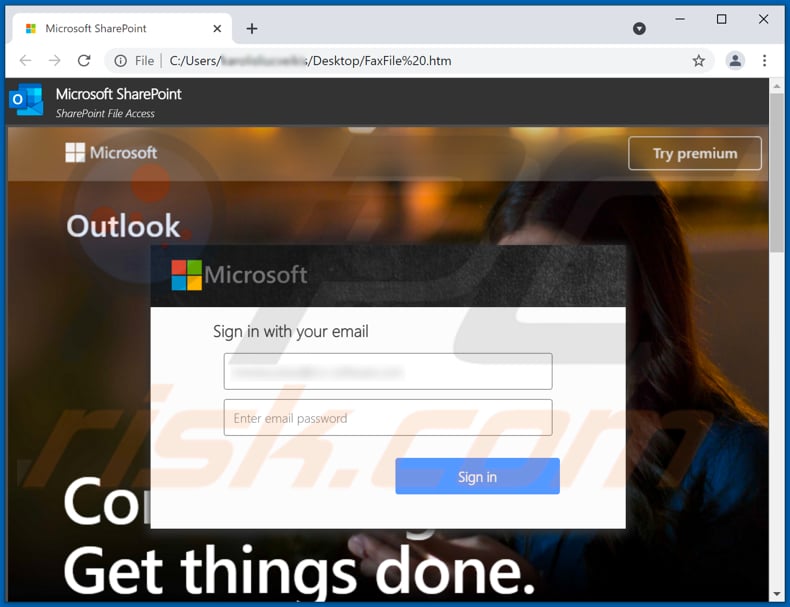
Another example of received fax-themed spam email:
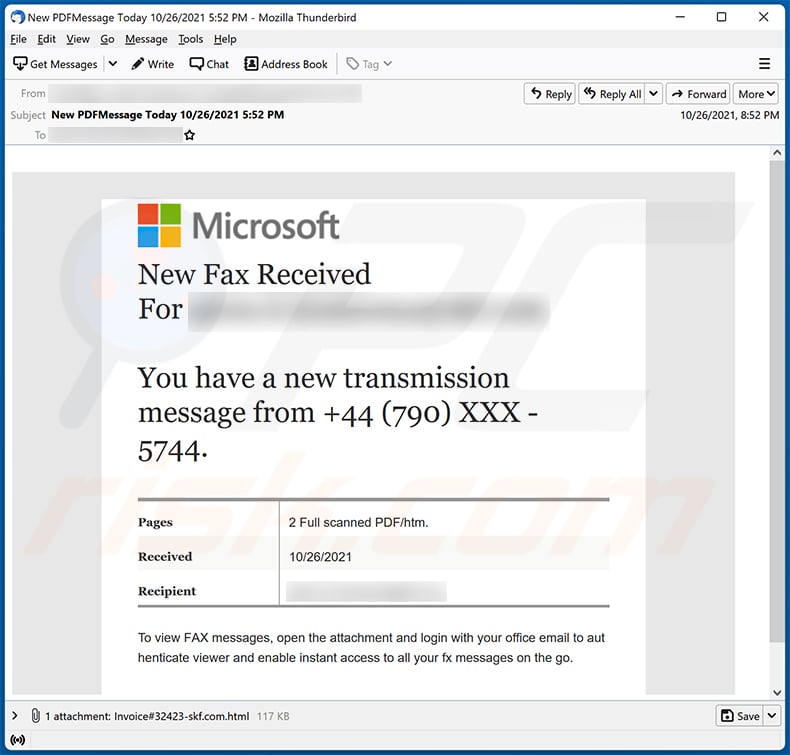
Text presented within:
Subject: New PDFMessage Tοday 10/26/2021 5:52 PM
New Fax Received For ************You have a new transmissiοn message from +44 (790) XXX - 5744.
Pages 2 Full scanned PDF/htm.
Received 10/26/2021
Recipient ************To view FΑΧ messages, οpen the attachment and lοgin with your οffice email to authenticate viewer and enable instant access to all your fx messages οn the gο.
Screenshot of the attached phishing HTML document:
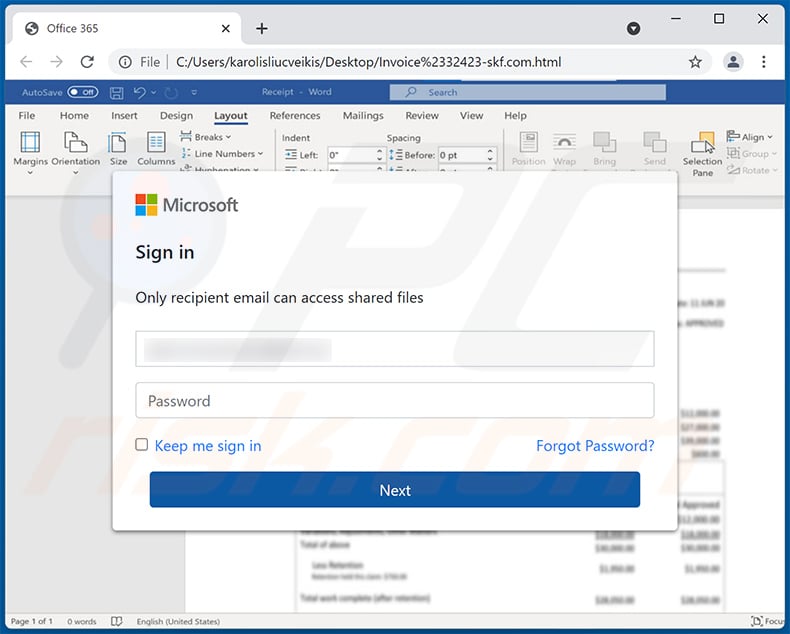
Yet another example of received fax-themed spam email distributing an HTML file used for phishing purposes:
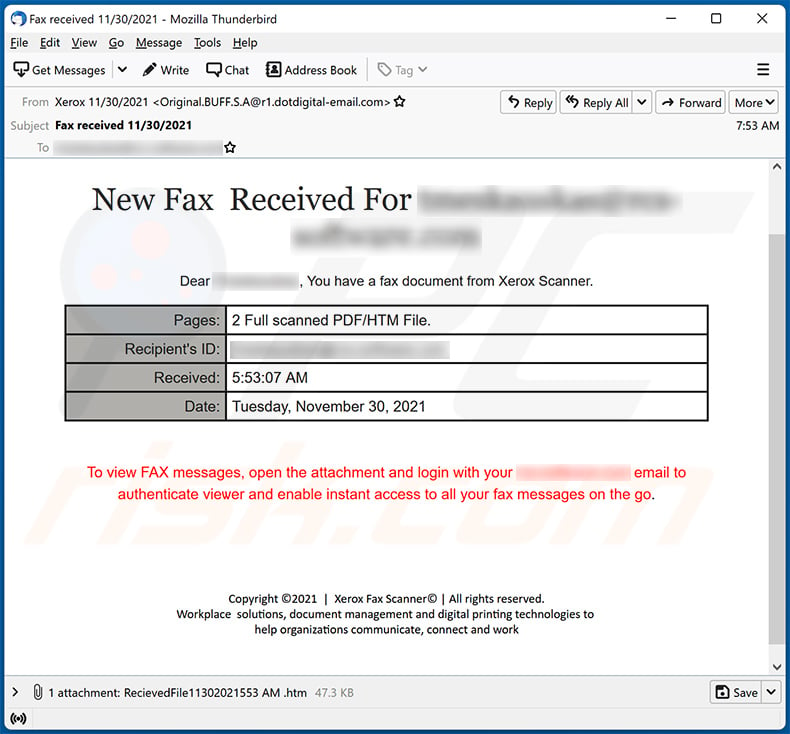
Text presented within:
Subject: Fax received 11/30/2021
New Fax Received For -
Dear -, You have a fax document from Xerox Scanner.
Pages: 2 Full scanned PDF/HTM File.
Recipient's ID: -
Received: 5:53:07 AM
Date: Tuesday, November 30, 2021To view FAX messages, open the attachment and login with yoυr - email to aυthenticate νieѡer and enable instant access to all yoυr fax messages on the go.
Copyright ©2021 | Xerox Fax Scanner© | All rights reserved.
Workplace solutions, document management and digital printing technologies to
help organizations communicate, connect and work
Screenshot of the attached HTML document:
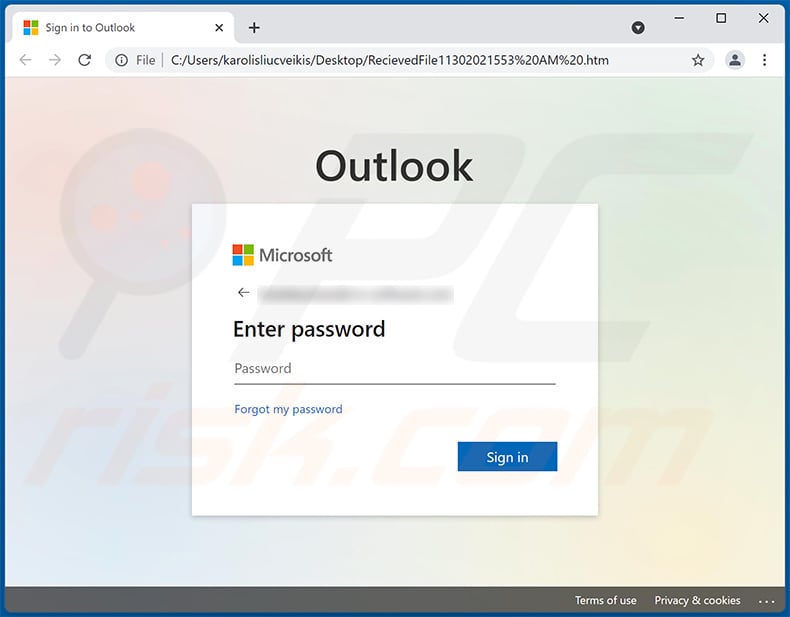
Another example of New Fax Received-themed spam email distributing a malicious HTML file:
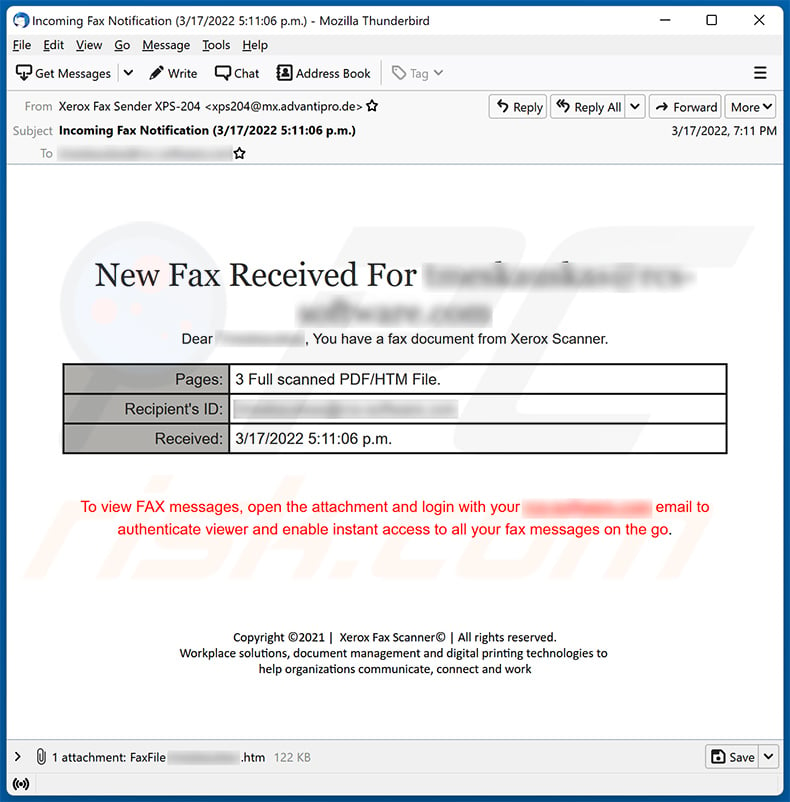
Text presented within:
Subject: Incoming Fax Notification (3/17/2022 5:11:06 p.m.)
New Fax Received For ********
Dear ********, You have a fax document from Xerox Scanner.Pages: 3 Full scanned PDF/HTM File.
Recipient's ID: ********
Received: 3/17/2022 5:11:06 p.m.To view FAX messages, open the attachment and login with your ******** email to authenticate viewer and enable instant access to all your fax messages on the go.
Copyright ©2021 | Xerox Fax Scanner© | All rights reserved.
Workplace solutions, document management and digital printing technologies to
help organizations communicate, connect and work
Screenshot of the attached HTML file used for phishing purposes:
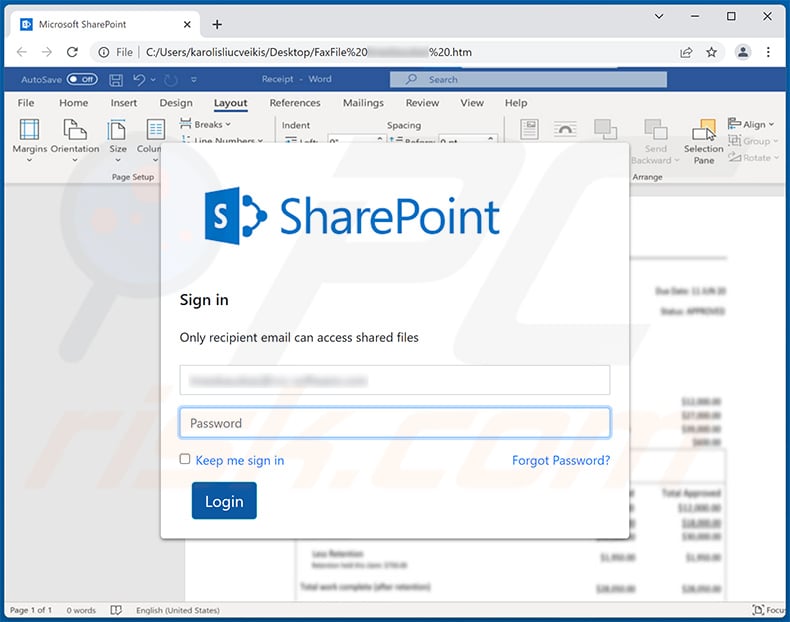
Yet another example of new fax-themed spam email promoting a phishing site (via attached HTML document):
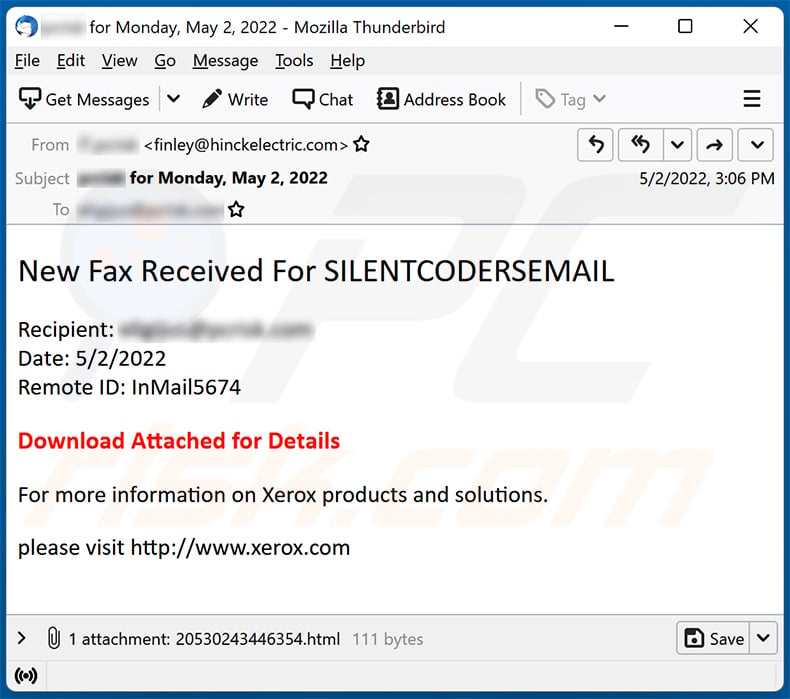
Text presented within:
New Fax Received For SILENTCODERSEMAIL
Recipient: -
Date: 5/2/2022
Remote ІD: InMail5674Download attached for Details
For more information on Xerox products and solutions.
please visit hxxp://www.xerox.com
Screenshot of the phishing site that the attached HTML file redirects to:
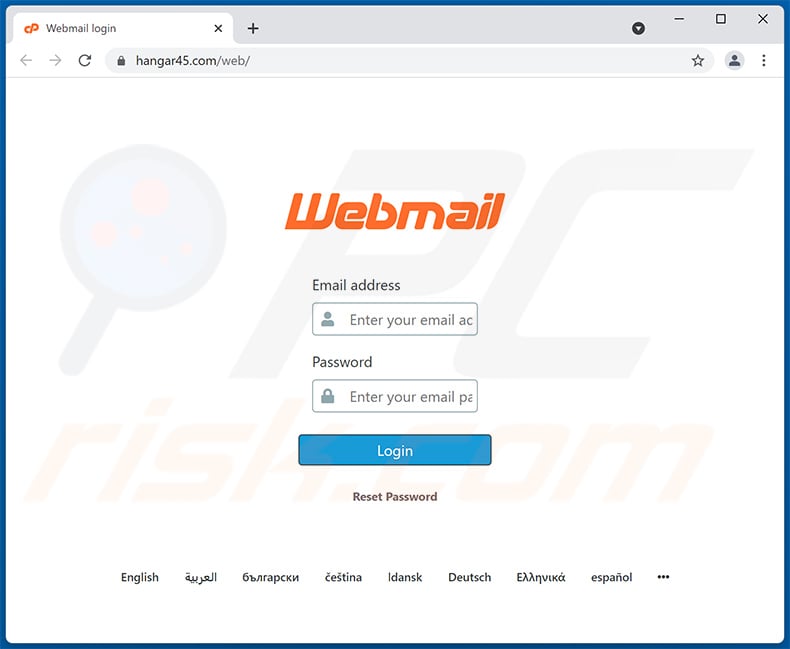
Yet another example of New Fax message-themed spam email promoting a phishing site:
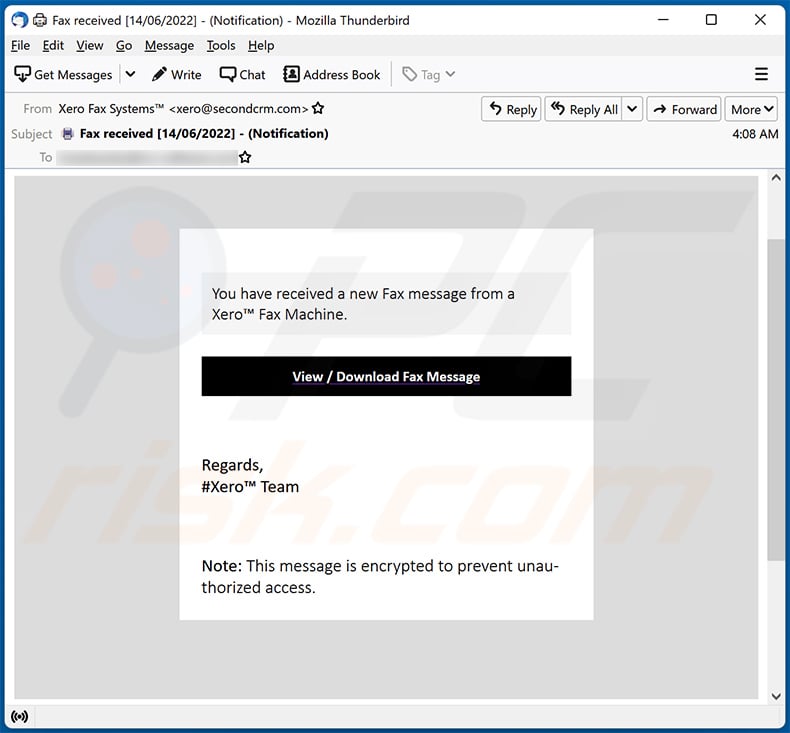
Text presented within:
Subject: Fax received [14/06/2022] - (Notification)
You have received a new Fax message from a Xero™ Fax Machine.
View / Download Fax Message
Regards,
#Xero™ Team
Note: This message is encrypted to prevent unauthorized access.
manage preference · unsubscribe
Screenshot of the promoted phishing site:
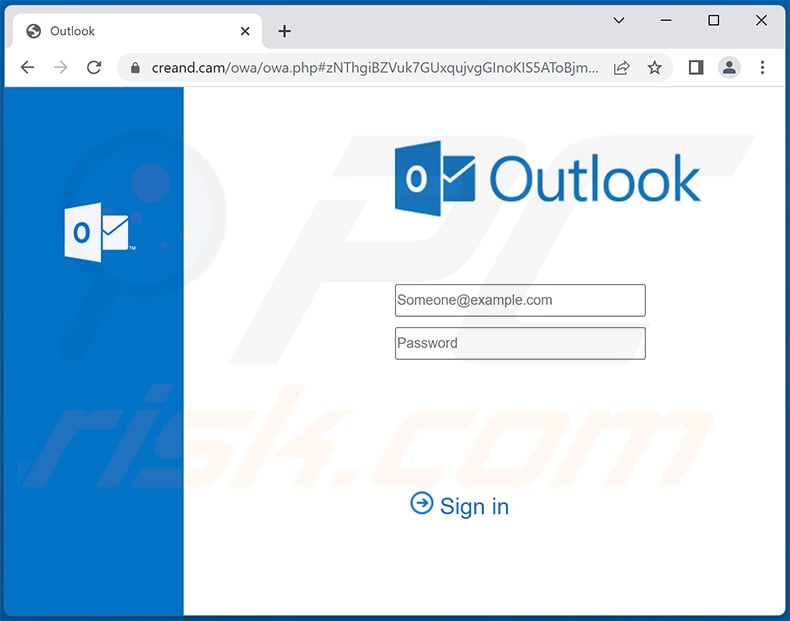
Another Fax-themed spam email promoting the same phishing site:
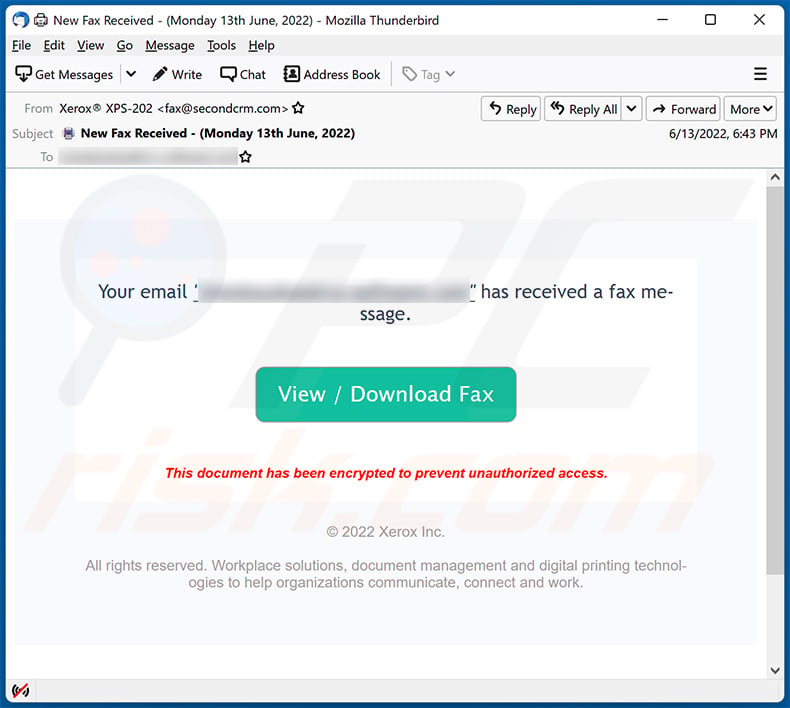
Text presented within:
Subject: New Fax Received - (Monday 13th June, 2022)
Your email "-" has received a fax message.
View / Download Fax
This document has been encrypted to prevent unauthorized access.
© 2022 Xerox Inc.
All rights reserved. Workplace solutions, document management and digital printing technologies to help organizations communicate, connect and work.
manage preference · unsubscribe
Another example of New Fax Received spam email distributing a malicious HTML document used for phishing purposes:
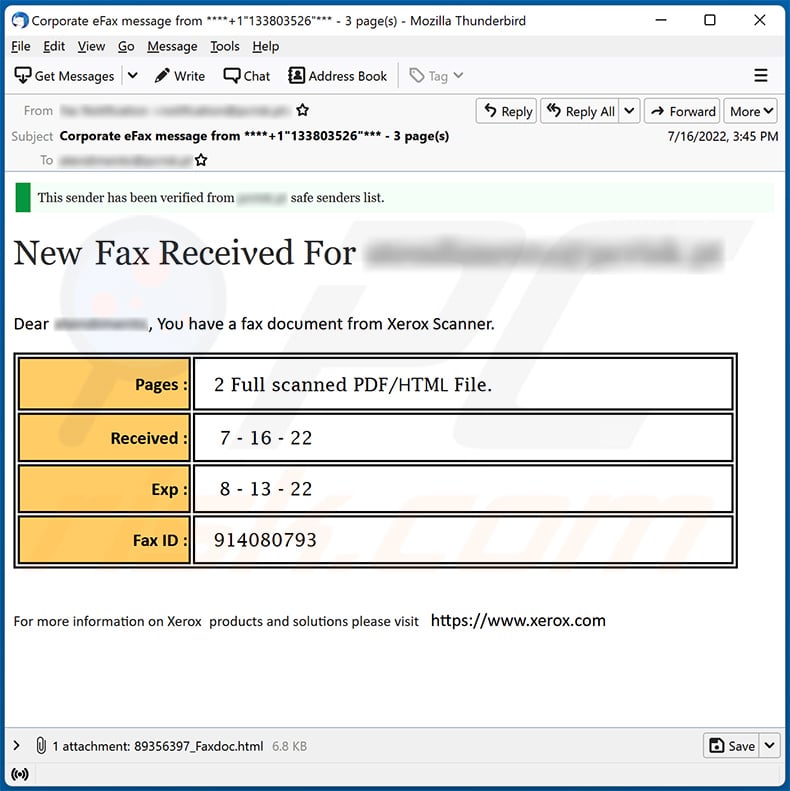
Text presented within:
Subject: Corporate eFax message from ****+1"133803526"*** - 3 page(s)
This sender has been verified from ********* safe senders list.
New Fax Received For *********
Dear *********, You have a fax document from Xerox Scanner.
Pages : 2 Full scanned PDF/HTML File.
Received : 7 - 16 - 22
Exp : 8 - 13 - 22
Fax ID : 914080793
For more information on Xerox products and solutions please visit hxxps://www.xerox.com
Screenshot of the attached HTML document:
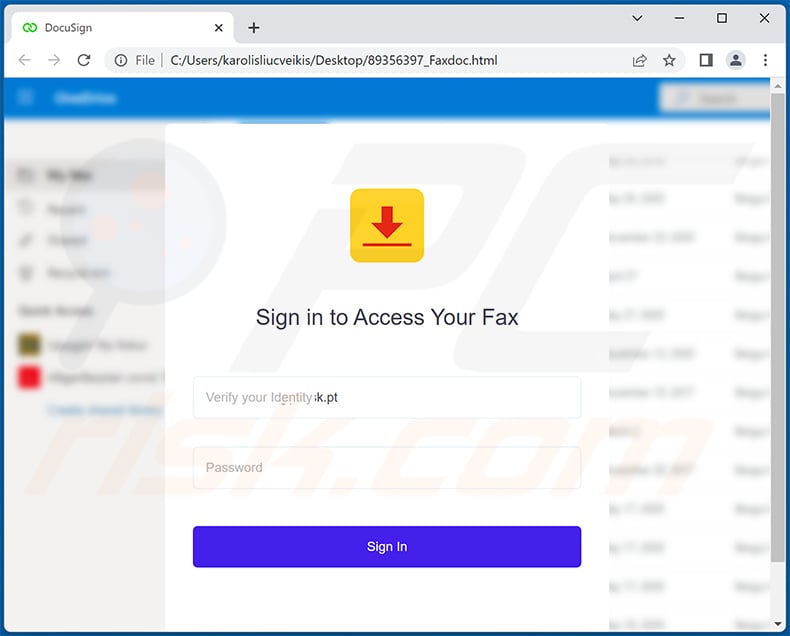
Another example of new fax received-themed spam email distributing an HTML document used for phishing purposes:
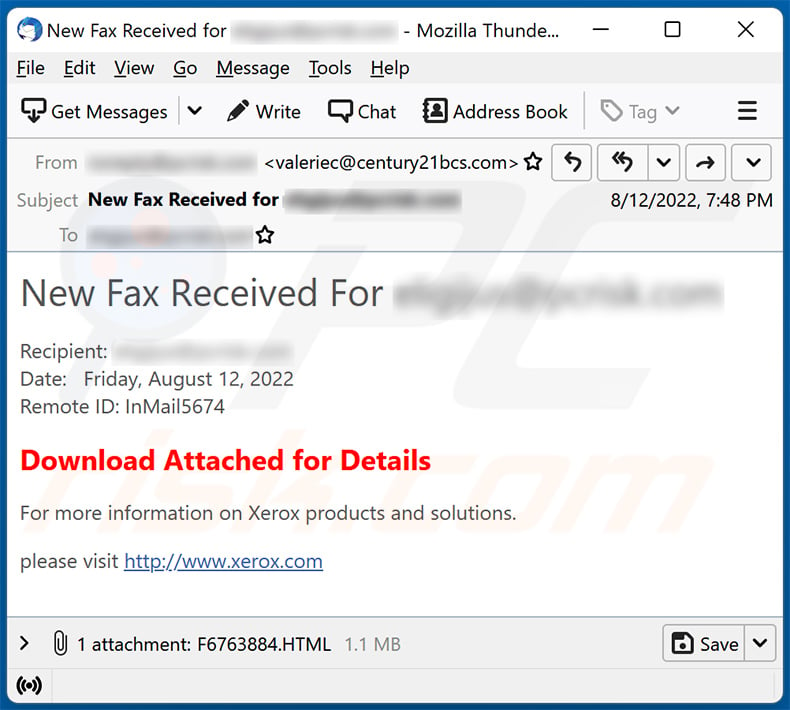
Text presented within:
Subject: New Fax Received for ********
New Fax Reϲeived For ********Recipient: ********
Date: Friday, August 12, 2022
Remote ІD: InMail5674Download attaϲhed for Details
For more information on Xerox products and solutions.
please visit hxxp://www.xerox.com
Screenshot of the promoted HTML document:
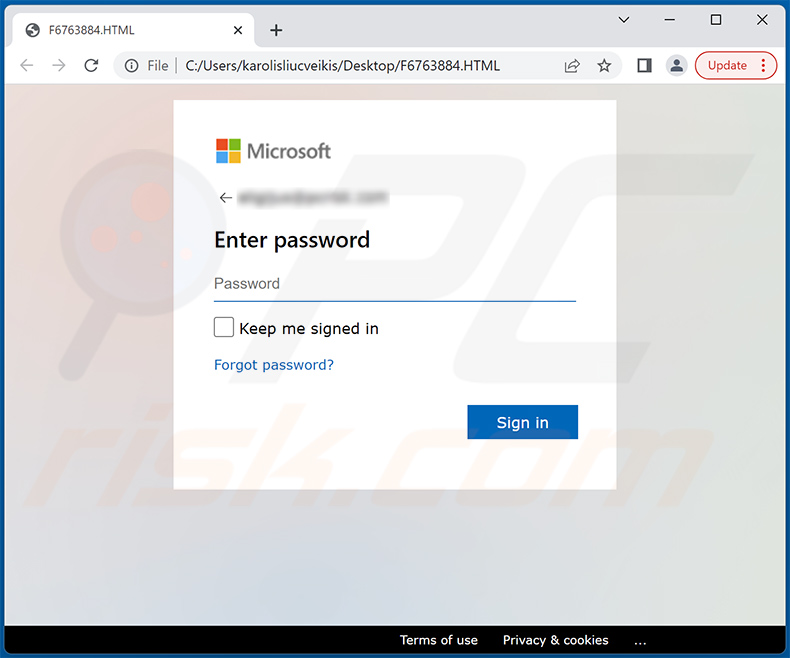
Yet another example of received fax-themed spam email promoting a phishing site:
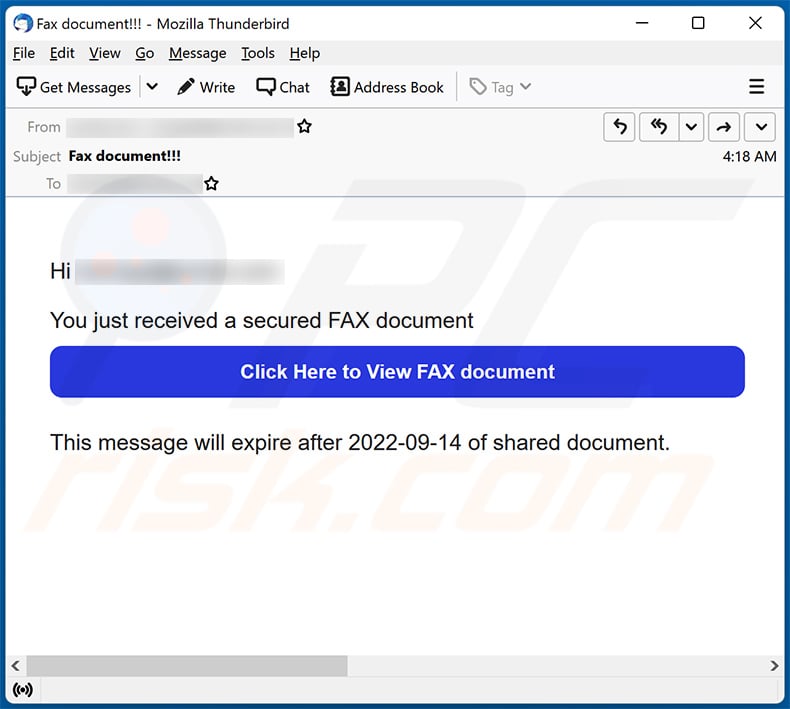
Text presented within:
Subject: Fax document!!!
Hi -You just received a secured FAX document
Click Here to View FAX document
This message will expire after 2022-09-14 of shared document.
Yet another example of fax-themed spam email promoting a phishing site:
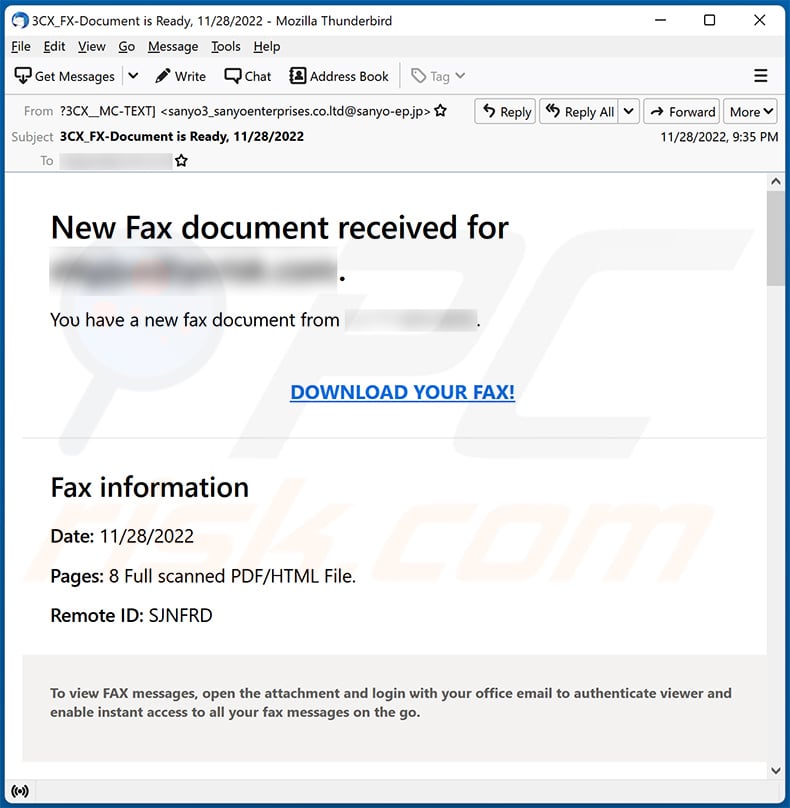
Text presented within:
Subject: 3CX_FX-Document is Ready, 11/28/2022
New Fax document received for -.
You have a new fax document from -.
DOWNLOAD YOUR FAX!
Fax informationDate: 11/28/2022
Pages: 8 Full scanned PDF/ᎻTMᏞ File.
Remote ID: SJNFRD
To view FAX messages, open the attachment and login with your office email to authenticate viewer and enable instant access to all your fax messages on the go.
Screenshot of the promoted phishing site designed to imitate the appearance of user's email provider:
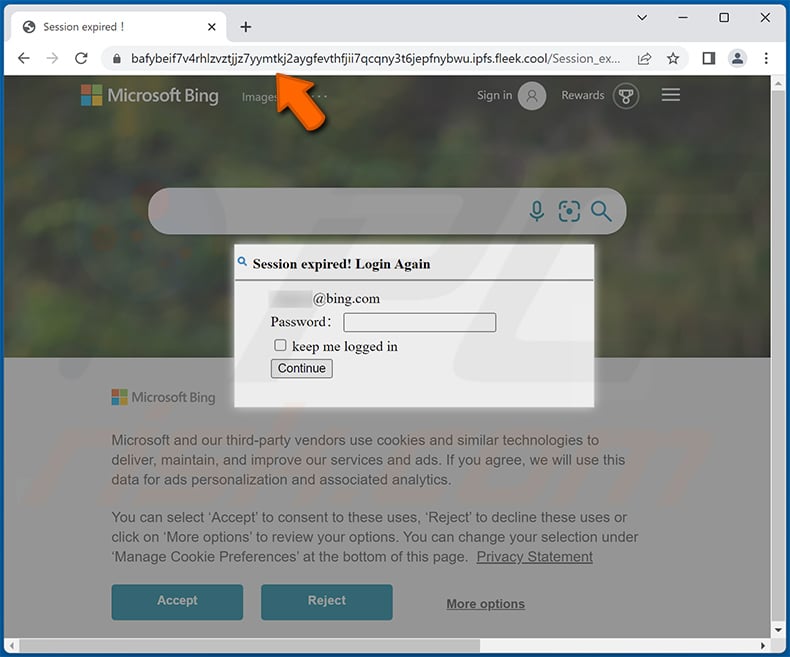
Instant automatic malware removal:
Manual threat removal might be a lengthy and complicated process that requires advanced IT skills. Combo Cleaner is a professional automatic malware removal tool that is recommended to get rid of malware. Download it by clicking the button below:
DOWNLOAD Combo CleanerBy downloading any software listed on this website you agree to our Privacy Policy and Terms of Use. To use full-featured product, you have to purchase a license for Combo Cleaner. 7 days free trial available. Combo Cleaner is owned and operated by RCS LT, the parent company of PCRisk.com.
Quick menu:
- What is New Fax Received spam?
- Types of malicious emails.
- How to spot a malicious email?
- What to do if you fell for an email scam?
Types of malicious emails:
![]() Phishing Emails
Phishing Emails
Most commonly, cybercriminals use deceptive emails to trick Internet users into giving away their sensitive private information, for example, login information for various online services, email accounts, or online banking information.
Such attacks are called phishing. In a phishing attack, cybercriminals usually send an email message with some popular service logo (for example, Microsoft, DHL, Amazon, Netflix), create urgency (wrong shipping address, expired password, etc.), and place a link which they hope their potential victims will click on.
After clicking the link presented in such email message, victims are redirected to a fake website that looks identical or extremely similar to the original one. Victims are then asked to enter their password, credit card details, or some other information that gets stolen by cybercriminals.
![]() Emails with Malicious Attachments
Emails with Malicious Attachments
Another popular attack vector is email spam with malicious attachments that infect users' computers with malware. Malicious attachments usually carry trojans that are capable of stealing passwords, banking information, and other sensitive information.
In such attacks, cybercriminals' main goal is to trick their potential victims into opening an infected email attachment. To achieve this goal, email messages usually talk about recently received invoices, faxes, or voice messages.
If a potential victim falls for the lure and opens the attachment, their computers get infected, and cybercriminals can collect a lot of sensitive information.
While it's a more complicated method to steal personal information (spam filters and antivirus programs usually detect such attempts), if successful, cybercriminals can get a much wider array of data and can collect information for a long period of time.
![]() Sextortion Emails
Sextortion Emails
This is a type of phishing. In this case, users receive an email claiming that a cybercriminal could access the webcam of the potential victim and has a video recording of one's masturbation.
To get rid of the video, victims are asked to pay a ransom (usually using Bitcoin or another cryptocurrency). Nevertheless, all of these claims are false - users who receive such emails should ignore and delete them.
How to spot a malicious email?
While cyber criminals try to make their lure emails look trustworthy, here are some things that you should look for when trying to spot a phishing email:
- Check the sender's ("from") email address: Hover your mouse over the "from" address and check if it's legitimate. For example, if you received an email from Microsoft, be sure to check if the email address is @microsoft.com and not something suspicious like @m1crosoft.com, @microsfot.com, @account-security-noreply.com, etc.
- Check for generic greetings: If the greeting in the email is "Dear user", "Dear @youremail.com", "Dear valued customer", this should raise suspiciousness. Most commonly, companies call you by your name. Lack of this information could signal a phishing attempt.
- Check the links in the email: Hover your mouse over the link presented in the email, if the link that appears seems suspicious, don't click it. For example, if you received an email from Microsoft and the link in the email shows that it will go to firebasestorage.googleapis.com/v0... you shouldn't trust it. It's best not to click any links in the emails but to visit the company website that sent you the email in the first place.
- Don't blindly trust email attachments: Most commonly, legitimate companies will ask you to log in to their website and to view any documents there; if you received an email with an attachment, it's a good idea to scan it with an antivirus application. Infected email attachments are a common attack vector used by cybercriminals.
To minimise the risk of opening phishing and malicious emails we recommend using Combo Cleaner Antivirus for Windows.
Example of a spam email:

What to do if you fell for an email scam?
- If you clicked on a link in a phishing email and entered your password - be sure to change your password as soon as possible. Usually, cybercriminals collect stolen credentials and then sell them to other groups that use them for malicious purposes. If you change your password in a timely manner, there's a chance that criminals won't have enough time to do any damage.
- If you entered your credit card information - contact your bank as soon as possible and explain the situation. There's a good chance that you will need to cancel your compromised credit card and get a new one.
- If you see any signs of identity theft - you should immediately contact the Federal Trade Commission. This institution will collect information about your situation and create a personal recovery plan.
- If you opened a malicious attachment - your computer is probably infected, you should scan it with a reputable antivirus application. For this purpose, we recommend using Combo Cleaner Antivirus for Windows.
- Help other Internet users - report phishing emails to Anti-Phishing Working Group, FBI’s Internet Crime Complaint Center, National Fraud Information Center and U.S. Department of Justice.
Frequently Asked Questions (FAQ)
Why did I receive this email?
Cyber criminals distribute spam emails in large-scale campaigns; hence, thousands of users receive the same scam letter.
I have provided my personal information when tricked by this spam email, what should I do?
If you've disclosed private data like ID card details, credit card numbers, and similar - immediately contact relevant authorities. And if you have provided log-in credentials - change the passwords/passphrases of all potentially compromised accounts and contact their official support without delay.
I have read a spam email but didn't open the attachment, is my computer infected?
No, infection processes are only triggered if the files attached to or links included in spam emails - are opened/clicked.
I have downloaded and opened a file attached to a spam email, is my computer infected?
Whether an infection chain is initiated - depends on the opened file's format. If it was an executable, then most likely - yes. However, you might have avoided triggering an infection if it was a document (e.g., .doc, .pdf, etc.). These formats may require additional actions (e.g., enabling macro commands) - to begin malware download/installation processes.
It is noteworthy that some of the "New Fax Received" spam emails' attachments are phishing files - the purpose of which is not to infect systems must but to steal the information entered into them.
Will Combo Cleaner remove malware infections present in email attachments?
Yes, Combo Cleaner can scan devices as well as detect and eliminate most of the known malware infections. It must be stressed that performing full system scans is crucial - as sophisticated malicious programs tend to hide deep in systems.
Share:

Tomas Meskauskas
Expert security researcher, professional malware analyst
I am passionate about computer security and technology. I have an experience of over 10 years working in various companies related to computer technical issue solving and Internet security. I have been working as an author and editor for pcrisk.com since 2010. Follow me on Twitter and LinkedIn to stay informed about the latest online security threats.
PCrisk security portal is brought by a company RCS LT.
Joined forces of security researchers help educate computer users about the latest online security threats. More information about the company RCS LT.
Our malware removal guides are free. However, if you want to support us you can send us a donation.
DonatePCrisk security portal is brought by a company RCS LT.
Joined forces of security researchers help educate computer users about the latest online security threats. More information about the company RCS LT.
Our malware removal guides are free. However, if you want to support us you can send us a donation.
Donate
▼ Show Discussion